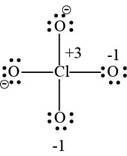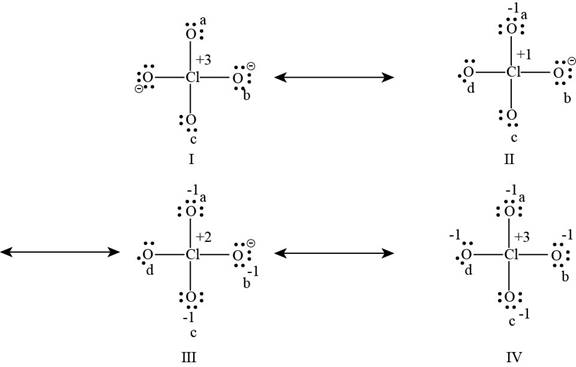
Concept explainers
Interpretation: The Lewis structure and shape of the given compound, the hybridization of the central atom and the resonating structure that has formal charge close to zero is to be identified.
Concept introduction: The Lewis structure represents all bonding and non-bonding electrons surrounding the atoms involved in a molecule. A molecule exhibits a particular geometry in space considering the steric hindrances of the bond pairs and the lone pairs of electron.
Resonance structures are different forms of a molecule in which the chemical connectivity of the atoms in a molecule is same but there distribution of electrons is different.
The formal charge is calculated by the formula,
To determine: The Lewis structure and shape of the given compound, the hybridization of the central atom and the resonating structure that has formal charge close to zero.
Answer to Problem 9.65QP
Solution
The Lewis structure of
The resonating structure I has formal charge close to zero.
The shape of the molecule is tetrahedral and the hybridization of the chlorine is
Explanation of Solution
Explanation
The
The electronic configuration of
The number of valence electrons of
The atomic number of
The electronic configuration of
The number of valence electrons of
The total number of valence electrons of
The Lewis structure of

Figure 1
Resonance structures are different forms of a molecule in which the chemical connectivity of the atoms in a molecule is same but there distribution of electrons is different.
The resonance structure of

Figure 2
The formal charge is calculated by the formula,
According to the I resonating structure of the given compound from figure 2,
- Chlorine has fourteen bonding and zero nonbonding electrons.
- Oxygen (a) has four bonding electrons and four nonbonding electrons.
- Oxygen (b) has two bonding and six nonbonding electrons.
- Oxygen (c) has four bonding electrons and four nonbonding electrons.
- Oxygen (d) has four bonding and four nonbonding electrons.
The formal charge of chlorine in resonating structure 1 is calculated as,
The formal charge of oxygen (a) in resonating structure 1 is calculated as,
The formal charge of oxygen (b) in resonating structure 1 is calculated as,
The formal charge of oxygen (c) in resonating structure 1 is calculated as,
The formal charge of oxygen (d) in resonating structure 1 is calculated as,
According to the II resonating structure of the given compound from figure 2,
- Chlorine has twelve bonding and zero nonbonding electrons.
- Oxygen (a) has two bonding electrons and six nonbonding electrons.
- Oxygen (b) has two bonding and six nonbonding electrons.
- Oxygen (c) has four bonding electrons and four nonbonding electrons.
- Oxygen (d) has four bonding and four nonbonding electrons.
The formal charge of chlorine in resonating structure 1 is calculated as,
The formal charge of oxygen (a) in resonating structure 1 is calculated as,
The formal charge of oxygen (b) in resonating structure 1 is calculated as,
The formal charge of oxygen (c) in resonating structure 1 is calculated as,
The formal charge of oxygen (d) in resonating structure 1 is calculated as,
According to the II resonating structure of the given compound from figure 2,
- Chlorine has fourteen bonding and zero nonbonding electrons.
- Oxygen (a) has four bonding electrons and six nonbonding electrons.
- Oxygen (b) has two bonding and six nonbonding electrons.
- Oxygen (c) has four bonding electrons and six nonbonding electrons.
- Oxygen (d) has four bonding and four nonbonding electrons.
The formal charge of chlorine in resonating structure 1 is calculated as,
The formal charge of oxygen (a) in resonating structure 1 is calculated as,
The formal charge of oxygen (b) in resonating structure 1 is calculated as,
The formal charge of oxygen (c) in resonating structure 1 is calculated as,
The formal charge of oxygen (d) in resonating structure 1 is calculated as,
According to the IV resonating structure of the given compound from figure 2,
- Chlorine has ten bonding and zero nonbonding electrons.
- Oxygen (a) has two bonding electrons and six nonbonding electrons.
- Oxygen (b) has two bonding and six nonbonding electrons.
- Oxygen (c) has two bonding electrons and six nonbonding electrons.
- Oxygen (d) has four bonding and four nonbonding electrons.
The formal charge of chlorine in resonating structure 1 is calculated as,
The formal charge of oxygen (a) in resonating structure 1 is calculated as,
The formal charge of oxygen (b) in resonating structure 1 is calculated as,
The formal charge of oxygen (c) in resonating structure 1 is calculated as,
The formal charge of oxygen (d) in resonating structure 1 is calculated as,
Resonating structure 1 has formal charge close to zero
The molecular shape of
From the resonating structure I it is concluded that the chlorine atom forms three pi bonds this means it uses three
Conclusion
The Lewis structure of
The resonating structure I has formal charge close to zero.
The shape of the molecule is tetrahedral and the hybridization of the chlorine is
Want to see more full solutions like this?
Chapter 9 Solutions
Chemistry: The Science in Context (Fourth Edition)
- What are the major products of the following organic reaction? Please include a detailed explanation as well as a drawing as to how the reaction proceeds.arrow_forwardWhat are the major products of the following reaction? Please provide a detailed explanation and a drawing to show how the reaction proceeds.arrow_forwardWhat are the major products of the following organic reaction? Please include a detailed explanation as well as a drawing as to how the reaction proceeds.arrow_forward
- Predict the organic product that forms in the reaction below: H + гон OH H+ H+ ☑ O Note: You may assume you have an excess of either reactant if the reaction requires more than one of those molecules to form the product. In the drawing area below, draw the skeletal ("line") structure of the missing organic product X. Explanation Check Click and drag to start drawing a structure. S 2025 McGraw Hill LLC. All Rights Reserved. Terms of Use | Privacy Centearrow_forwardIn the analysis of Mg content in a 25 mL sample, a titration volume of 5 mL was obtained using 0.01 M EDTA. Calculate the Mg content in the sample if the Ca content is 20 ppmarrow_forwardPredict the organic products that form in the reaction below: H. H+ + OH H+ Y Note: You may assume you have an excess of either reactant if the reaction requires more than one of those molecules to form the products. In the drawing area below, draw the skeletal ("line") structures of the missing organic products X and Y. You may draw the structures in any arrangement that you like, so long as they aren't touching. Explanation Check Click and drag to start drawing a structure. G X C © 2025 McGraw Hill LLC. All Rights Reserved. Terms of Use | Privacy Center | Access +arrow_forward
- 111 Carbonyl Chem Choosing reagants for a Wittig reaction What would be the best choices for the missing reagents 1 and 3 in this synthesis? 1. PPh3 3 1 2 2. n-BuLi • Draw the missing reagents in the drawing area below. You can draw them in any arrangement you like. Do not draw the missing reagent 2. If you draw 1 correctly, we'll know what it is. • Note: if one of your reagents needs to contain a halogen, use bromine. Explanation Check Click and drag to start drawing a structure. × ©2025 McGraw Hill LLC. All Rights Reserved. Terms of Usearrow_forwardA student proposes the transformation below in one step of an organic synthesis. There may be one or more reactants missing from the left-hand side, but there are no products missing from the right-hand side. There may also be catalysts, small inorganic reagents, and other important reaction conditions missing from the arrow. • Is the student's transformation possible? If not, check the box under the drawing area. . If the student's transformation is possible, then complete the reaction by adding any missing reactants to the left-hand side, and adding required catalysts, inorganic reagents, or other important reaction conditions above and below the arrow. • You do not need to balance the reaction, but be sure every important organic reactant or product is shown. + T X O O лет-ле HO OH HO OH This transformation can't be done in one step.arrow_forwardDetermine the structures of the missing organic molecules in the following reaction: X+H₂O H* H+ Y OH OH Note: Molecules that share the same letter have the exact same structure. In the drawing area below, draw the skeletal ("line") structures of the missing organic molecules X and Y. You may draw the structures in any arrangement that you like, so long as they aren't touching. Click and drag to start drawing a structure. X Sarrow_forward
- Predict the major products of this organic reaction. If there aren't any products, because nothing will happen, check the box under the drawing area instead. No reaction. HO. O :☐ + G Na O.H Click and drag to start drawing a structure. XS xs H₂Oarrow_forwardWhat are the angles a and b in the actual molecule of which this is a Lewis structure? H H C H- a -H b H Note for advanced students: give the ideal angles, and don't worry about small differences from the ideal groups may have slightly different sizes. a = b = 0 °arrow_forwardWhat are the angles a and b in the actual molecule of which this is a Lewis structure? :0: HCOH a Note for advanced students: give the ideal angles, and don't worry about small differences from the ideal that might be caused by the fact that different electron groups may have slightly different sizes. a = 0 b=0° Sarrow_forward
 ChemistryChemistryISBN:9781305957404Author:Steven S. Zumdahl, Susan A. Zumdahl, Donald J. DeCostePublisher:Cengage Learning
ChemistryChemistryISBN:9781305957404Author:Steven S. Zumdahl, Susan A. Zumdahl, Donald J. DeCostePublisher:Cengage Learning ChemistryChemistryISBN:9781259911156Author:Raymond Chang Dr., Jason Overby ProfessorPublisher:McGraw-Hill Education
ChemistryChemistryISBN:9781259911156Author:Raymond Chang Dr., Jason Overby ProfessorPublisher:McGraw-Hill Education Principles of Instrumental AnalysisChemistryISBN:9781305577213Author:Douglas A. Skoog, F. James Holler, Stanley R. CrouchPublisher:Cengage Learning
Principles of Instrumental AnalysisChemistryISBN:9781305577213Author:Douglas A. Skoog, F. James Holler, Stanley R. CrouchPublisher:Cengage Learning Organic ChemistryChemistryISBN:9780078021558Author:Janice Gorzynski Smith Dr.Publisher:McGraw-Hill Education
Organic ChemistryChemistryISBN:9780078021558Author:Janice Gorzynski Smith Dr.Publisher:McGraw-Hill Education Chemistry: Principles and ReactionsChemistryISBN:9781305079373Author:William L. Masterton, Cecile N. HurleyPublisher:Cengage Learning
Chemistry: Principles and ReactionsChemistryISBN:9781305079373Author:William L. Masterton, Cecile N. HurleyPublisher:Cengage Learning Elementary Principles of Chemical Processes, Bind...ChemistryISBN:9781118431221Author:Richard M. Felder, Ronald W. Rousseau, Lisa G. BullardPublisher:WILEY
Elementary Principles of Chemical Processes, Bind...ChemistryISBN:9781118431221Author:Richard M. Felder, Ronald W. Rousseau, Lisa G. BullardPublisher:WILEY





